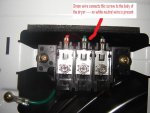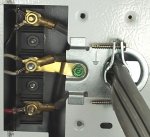Craig Johnson
Member
- Messages
- 113
- Location
- The Couv, Washington
Hi everyone.
I have my new Steel City table saw that I got about a week ago.
I have been getting the pieces I need to adapt it to use my dryer outlet (2 tapered slanted slots and one L shaped) so I can power it up with the proper voltage.
I bought some 10/3 Romex and a 6 foot dryer cord at Lowes.
I spent most of today cutting/splicing wires and making my own extension cord. I double checked everything and plugged it in. Flipped the switch and.......nothing. Does not turn the saw on.
I have been doing some more research and it looks as if the center lug is not a ground but a neutral. I am not sure if this has something to do with this or not. Our house was build in 95.
I do not have the funds to have an electrician come out and give me info or wire a proper 220 outlet.
So at this point I thought I had it right but have no power to the saw. I will also add I do not have a multimeter to see if voltage is at switch.
I thought for sure I had it right but could there be something I am overlooking?
I am trying to educate myself as best I can and want to make sure this extension cord is done correctly and will work properly.
Geez at this point I might even be willing to pay someone to build one of these and send it to me.
Please anyone who has this same scenario please let me know if you can help.
Thanks,
Craig
I have my new Steel City table saw that I got about a week ago.
I have been getting the pieces I need to adapt it to use my dryer outlet (2 tapered slanted slots and one L shaped) so I can power it up with the proper voltage.
I bought some 10/3 Romex and a 6 foot dryer cord at Lowes.
I spent most of today cutting/splicing wires and making my own extension cord. I double checked everything and plugged it in. Flipped the switch and.......nothing. Does not turn the saw on.
I have been doing some more research and it looks as if the center lug is not a ground but a neutral. I am not sure if this has something to do with this or not. Our house was build in 95.
I do not have the funds to have an electrician come out and give me info or wire a proper 220 outlet.
So at this point I thought I had it right but have no power to the saw. I will also add I do not have a multimeter to see if voltage is at switch.
I thought for sure I had it right but could there be something I am overlooking?
I am trying to educate myself as best I can and want to make sure this extension cord is done correctly and will work properly.
Geez at this point I might even be willing to pay someone to build one of these and send it to me.
Please anyone who has this same scenario please let me know if you can help.
Thanks,
Craig











 )
)




